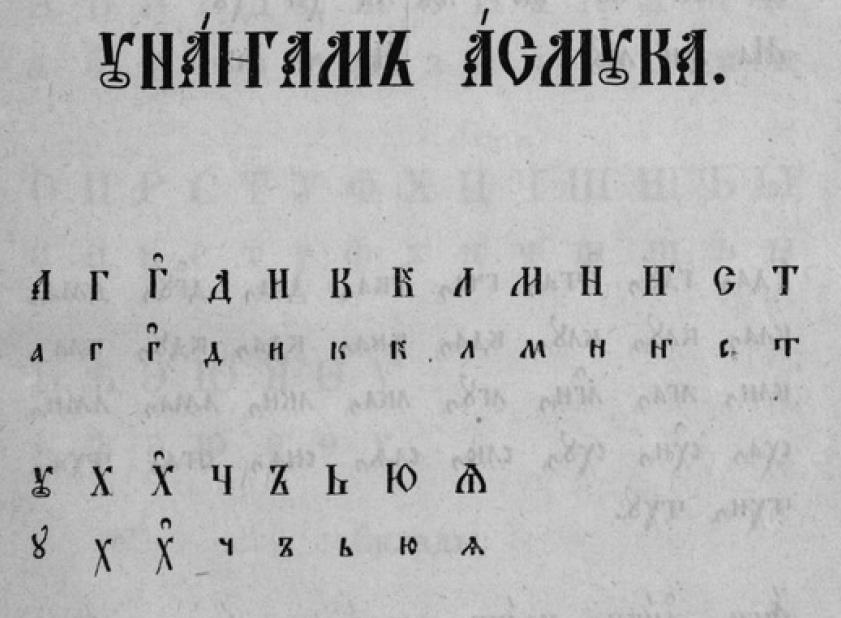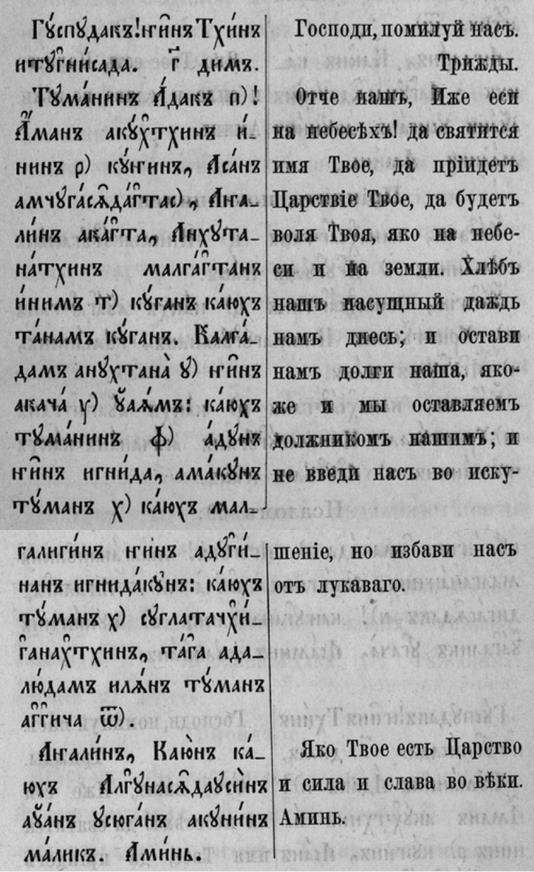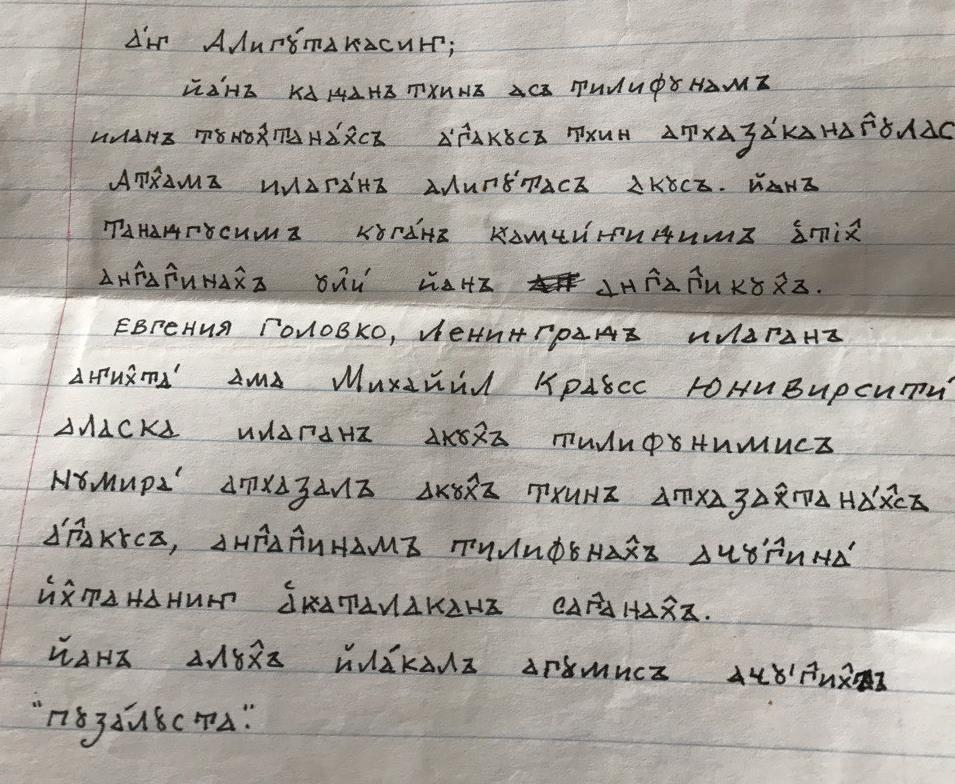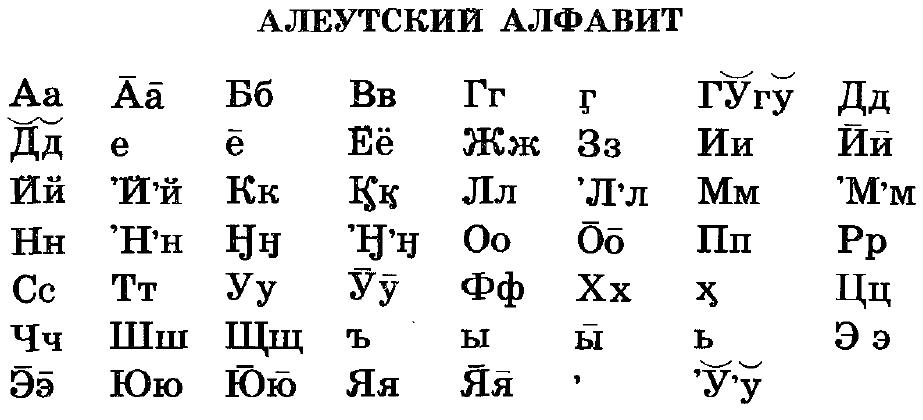Institute of Linguistic Studies, Russian Academy of Sciences
M. Muslimov
Bering Island Aleut
I. Sociolinguistic Data
I.1. Existing alternative names
Traditionally, the name Aleut is used for the very language described in this article. But in reality, to describe the version of the Aleut language used in Russia, it would have been more appropriate to talk about Bering Island Aleut (based on the name of Bering Island, one of the Commander Islands, inhabited by Aleuts who spoke this language). The fact is that Bering Island Aleut is not the only language spoken (or used to be spoken, to be precise) by Aleuts in Russia: there is also Mednyj Aleut, a very rare linguistic phenomenon. It is a so-called mixed language: in some cases of intensive contacts between speakers of two languages of different types, a third language, combining the features of the two aforementioned languages, is born. In such cases, the vocabulary, for example, originates chiefly from one language, whereas grammar, from the other. If it occurs, such language continues to exist independently, just like any other language, with its own fixed vocabulary, clear grammar rules, etc. In linguistics, these languages are called mixed. Among such mixed languages, there is Mednyj Aleut where intertwine the elements of Russian and Aleut. Our Atlas features a separate chapter dedicated to Mednyj Aleut {link to article}, whereas this article analyzes Bering Island Aleut. Bering Island Aleuts themselves call their language
унаӈам умсуу
. In addition, Bering Island Aleut is one of the Aleut dialects spoken on all Aleutian Islands and in the east of the Alaska Peninsula, as discussed further.
I. 2. General Characteristics
2.1.
Total number of speakers and their ethnic group
At present, there are no more Aleut native speakers in Russia: the last native speaker of Bering Island Aleut, Vera Timoshenko, died on March 6, 2021, aged 94, and the last native speaker of Mednyj Aleut, who learned Bering Island Aleut by himself, Gennady Yakovlev, died on October 4, 2022. At the same time, the language did not completely disappear from the linguistic map of the world: Aleut speakers (as you might have guessed from the name) live on the Aleutian Islands, and only a small part of this archipelago is administratively included in Kamchatka Krai (to be precise, only the islands that constitute its eastern extremity, the Commander Islands). Its biggest part is on the US territory and belongs to Alaska. Thus, most of the Aleuts now live on the US soil (not only on the islands of the Aleut Archipelago, but also in the eastern part of the Alaska Peninsula following the arch of volcanic Aleut Islands, and the Pribilof islands), and they still speak Aleut there.
Based on the 2010 Census, the total number of Aleuts on the Russian territory was 482 people. Specialists of the Alaska Native Language Center (Fairbanks) estimate
the number of Aleuts living in the USA
today
at around 2 200, and about one hundred of them speak Aleut.
I.2.2. Age structure of native speakers
Nowadays, nobody speaks Aleut in Russia. By the end of the 20
th
century, we disposed of the following sociolinguistic data regarding Aleuts in America (listed by islands) [Hallamaa 1995; 1997]: Atka – 44 (the youngest speaker is aged 25), Akutan – 4 (the youngest is aged 70), St. Paul island – 40 (the youngest is at least 50 years old), St. George Island – 15 people (the youngest are aged over 50), King Cove – 10 (the youngest are aged over 60).
I.2.3. Sociolinguistic characteristics
I.2.3.1. Threat of extinction
When it comes to Aleut in Russia, it can already be considered extinct: over the last few years, the language was in such a state that the researchers knew not only the exact number of last native speakers, but also all their names. But if we consider Aleut without taking into account the state borders, there are about 100 people that still speak the language. Nevertheless, there is no doubt that this number of speakers is still low and Aleut is threatened with extinction.
I.2.3.2. Use in various spheres
Today, Alaska is the only place Aleut is used in everyday life, at least to some extent. In Russia, the use of Aleut is now limited to optional courses at school. There are no Aleut schoolbooks in Russia, only a school dictionary published in 1994. In the US, Aleut schoolbooks were created in the 1970s – 1980s, above all, as part of the activities of the National Bilingual Materials Development Center in Anchorage. But in the 1990s, Aleut was excluded from the school curricula in Aliaska. Nowadays, the key education platform for those who wish to learn Aleut in Alaska is Internet, instead of school lessons. Firstly, some of the previously published textbooks are now available online, for example, Alaska Native Knowledge Network features The Introduction to Atkan Aleut Grammar and Lexicon compiled by
Knut Bergsland and Moses Dirks
. Secondly, numerous online resources are being developed in order to help all interested persons explore Aleut and learn its basics.
At the same time, attempts are being made in the USA to bring Aleut back into the school education system: currently, the Aleutian Pribilof Islands Association is elaborating a special certification program for future Aleut teachers.
I.2.4.
Information about written language and its existence
The first Cyrillic-based system of writing for Aleut was elaborated by a missionary priest Ivan Veniaminov
, who began his career as head of the Unalaska Department of the Kamchatka diocese of the Russian Orthodox Church (in the years he spent there, he also became a researcher of indigenous cultures of the Russian America)
. In 1846, he published the
first Aleut grammar book (
Опытъ грамматики алеутско-лисьевскаго языка священника И. Венiаминова въ Уналашкѣ
[Lesson in Aleut-Lisyev Grammar by Priest Veniaminov in Unalaska]) and the first ABC
Алеутскiй букварь
[Aleut ABC]. The ABC comprises the translations of Gospel texts into Aleut, its first pages feature the Aleut alphabet by father Veniaminov. He created it in 1826 in cooperation with Ivan Pankov, an Aleut native speaker, and used a Cyrillic base (its Church Slavonic version). Asf or the sounds that do not exist in Russian (and therefore, do not have any equivalent in the Russian alphabet), the authors used Cyrillic letters with additional lines. Image 1 recreates the alphabet page from Veniaminov’s ABC:

Image 1. Page with an alphabet,
Алеутский букварь
[Aleut ABC] by I. Veniaminov (1846 г.).

Image 2. Translation of “Our Father” into Aleut,
Алеутский букварь
[Aleut ABC] by I. Veniaminov.
It should be noted that Veniaminov’s efforts resulted in the literacy quickly gaining ground among Aleuts via a system of parochial schools; in the 19
th
century, there were publications of books in Aleut. The heyday of the Aleut written tradition coincided with the sale of Alaska and the Aleutian islands to the USA in 1867. It is fair to say that at that time no other indigenous peoples could compete with Aleuts when it came to literacy. V. Johelson, who researched the Aleutian islands in the early 20
th
century, pointed out that his respondents “are quite literate, i.e. they write in Aleut using Veniaminov’s alphabet...” The parochial schools, where they had lessons in Aleut and Russian and also taught these languages as separate courses, continued their existence in the US Alaska until 1912, so nearly half a century after the sale. Proficiency in Russian along with Aleut became a vital component of the new Aleut identity, in no small part due to the fact that Russian was the language of the Orthodox religion adopted by Aleuts. It is known that the educated Aleuts in Alaska used Russian language until the World War II, and even by the end of the 20
th
century, one can find traces of Veniaminov’s writing system used by American Aleuts.

The modern Aleut system of writing for Bering Island Aleuts was developed by E. Golovko. Below you can find this alphabet in the
Словарю алеутско-русскому и русско-алеутскому
[Aleut-Russian and Russian-Aleut Dictionary]:

Image 4. Cyrillic-based Aleut alphabet (based on the
Словарь алеутско-русскому и русско-алеутскому
[Aleut-Russian and Russian-Aleut Dictionary]).
Nowadays, Aleuts living on the US territory are using a Latin-based alphabet. Since the Atka dialect is very close to the Bering Island dialect, Russian readers interested in Aleut could use many US printed and online resources, provided they master this Latin-based Aleut alphabet. The image 4 represents the annex to the
Словарь алеутско-русскому и русско-алеутскому
[Aleut-Russian and Russian-Aleut Dictionary]
containing the rules of correlation between the two. Every symbol used to record original Aleut words always has a match in the other alphabet, apart from the letters used to record the recent borrowed words (English words in Atka Aleut, Russian in Bering Island Aleut).
Finally, there is a link for anyone interested in the Latin-based Aleut font
:
http://www.alaskool.org
.
Geographic Characteristics
3.1.
Subjects of the Russian Federation with compact residence of native speakers
Aleut district, Kamchatka Krai
3.2.
Total number of localities traditionally inhabited by native speakers
At present, there is only one settlement with Aleuts in Russia – the village of Nikolskoye on Bering Island, which is part of the Commander Islands (in the late 1960s, those Aleuts who spoke Mednyj Aleut and lived on the Mednyj Island were moved there too). Beyond the RF, as previously mentioned, Aleuts live on the islands of the Aleutian Archipelago, the eastern part of the Alaska Peninsula, and the Pribilof islands. It should be noted that the Commander Islands, the westernmost islands of the Commander and Aleutian volcanic ridge that separates the Bering Sea and the Pacific ocean, were never part of Aleut traditional settlements. Unlike the islands of the Aleutian ridge, the Commander Islands had no indigenous population, at least, there was found no reliable evidence of the existence of early inhabitants. Only in the first third of the 19
th
century do we find Aleuts on the Commander Islands (see Historical Dynamics).
I.3.3.
List of localities
The village of Nikolskoye (Bering Island) is the center of the Aleut National District (and basically their only permanent settlement within this area).
I.4. Historical Dynamics
This paragraph will discuss the following two topics: historical dynamics of the number of Aleuts and of their proficiency in native language.
It is commonly believed that prior to the arrival of Russians in the region in the mid-17th century, Aleuts lived in at least 160 rural settlements (stretching from Attu Island in the west to the Alaska Peninsula in the east). By the 1740s, the total population of Aleuts was estimated at no more 8-10 thousand people. Starting from 1743, Russian travelers and, above all, manufacturers started to arrive to the Aleutian Islands and Alaska, thus, the Russian colonization of the region began. Ever since that moment, indigenous people have been totally dependent on Russians. The first period of conquest was marked by the over-exploitation of the richest natural resources and regular extermination of the indigenous population. During the 40 years that followed the discovery of the Aleutian Islands by the Bering expedition in 1741, the total number of Aleuts had declined by five or six times, down to approximately 1500 people. In 1785, the Russian-American Company was founded. It was a major economic force where the movement of labor was determined mainly by the potential benefits; for example, it was a common occurrence to move Aleuts from one island to another. In the 1840s, RAC started to pay more attention to social issues, and the population began to grow a little, but it was never fully restored (among other things, due to outbreaks of various illnesses imported by Europeans and high infant mortality rates).
The Aleut population of the Commander Islands was also the result of the Aleut displacement by the Russian-American Company: in 1826, RAC began to bring Aleut workers from the Aleutian Islands and the Pribiloff Islands to other islands. By 1890, the population of two major Commander Islands amounted to 619 people: 345 people on Bering Island, 274, on Mednyj Island. Since then, the displacement process had stopped and the population began to decrease, and by the time of arrival of the Soviet administration (1920), there were 377 people on the islands (206 people on Bering Island, 171, on Mednyj Island).
Linguistic Data
II.1.
Position in the genealogical classification of world languages
Aleut is part of the Eskimo-Aleut (Eskaleut) language family. In its turn, this family consists of two branches: the Aleut branch comprising two languages, Aleut and Mednyj {see the corresponding Atlas article}, and the Eskimo. On the Russian territory, the Eskimo branch is represented by the Chaplino Eskimo language {see the corresponding Atlas article} and the Naukan Eskimo language {see the corresponding Atlas article}. More information about the Eskimo branch can be found in the article on Naukan Eskimos.
II.2. Dialects
According to researchers, three Aleut dialects existed on the traditional Aleut territory, the Aleutian Islands: Atkan
(or Western Aleut, on Atka Island), Unalaskan (or Eastern Aleut, on Fox Islands of the Aleutian ridge, Pribiloff Islands, and the eastern part of the Alaska Peninsula), and Attuan dialects (Attu Island). The Atkan and Unalaskan dialects are still spoken today. The story of the Attuan dialect, that no longer exists nowadays, is tragic: all Attuan native speakers were captured by Japanese during the World War II and relocated to Japan, where most of them died of diseases, poor living conditions, different climate, and unusual food. The surviving Attuans that came back to the USA after the war were housed on Atka, instead of their own island, which resulted in the definitive extinction of this Aleutian dialect.
There are two out of three above-mentioned dialects present on the Commander Islands: the Bering Island dialect is nearly identical to the Atka dialect, and the Mednyj is based on the Attuan.


























































